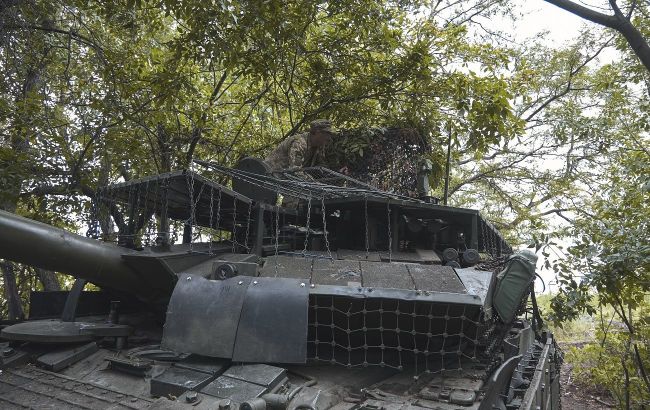In service with Ukraine's Forces now: How military capture advanced Russian T-90 Proryv tank
 Photo: Russian T-90 Proryv tank in service with the Ukrainian Armed Forces (RBC-Ukraine/Yevhen Samoilenko)
Photo: Russian T-90 Proryv tank in service with the Ukrainian Armed Forces (RBC-Ukraine/Yevhen Samoilenko)
In the Russia-Ukraine war, Russia often turns out to be the "supplier" of weapons. Ukrainian fighters effectively destroy enemy equipment, capture it as trophies, and then use it to defeat the enemy. Soldiers from the 68th Brigade managed to capture a Russian T-90 Proryv (Breakthrough) tank along with several other armored vehicles.
How this happened is detailed in the report by RBC-Ukraine military correspondent Bohdana Liaskivska.
How the Ukrainian Armed Forces сaptured a $1.5 million tank
The soldiers of the 68th Brigade are currently holding the defense in the Pokrovsk direction, where the enemy has an advantage in both personnel and technical resources. Daily, artillerymen and drone pilots try to destroy enemy equipment, but sometimes they can only eliminate personnel and seize trophies.
Recently, the defenders managed to capture several types of heavy equipment: a T-90 tank, a T-80, and a BMP. The most significant find is the latest Russian T-90 Proryv from 2023. Tank crews report that the interior still has the smell of fresh paint, indicating that the tank had likely seen only a few combat sorties.
Video: Russia's "Best" tank in service with the Ukrainian Armed Forces. How soldiers from the 68th brigade capture enemy equipment (youtube.com/RBC-Ukraine)
The T-90 is a Russian third-generation main battle tank, with an estimated cost of around $1.5 million per unit. In service with Russia since 1992, this tank has recently been upgraded. The new T-90 features a combined night vision device for the driver and a rear-view camera, enhancing its maneuverability. It weighs 48 tons.
The turret has a monoblock power unit, the V-93, producing 1,130 horsepower. Its armament includes a 125 mm gun with a firing range of up to 3,000 kilometers and machine guns. To date, 87 tanks of this type in various modifications have been identified and destroyed, with 18 captured in operational condition.
To make the Russian trophy useful to the Ukrainians, meticulous repair was necessary due to damage to the tank’s electrical system, which is crucial for its operation. According to the mechanic, the tank was 90 percent operational.
Securing the Proryv (Breakthrough) required a complex operation as the tank was located in an open area where Russian forces fired upon any approaching attempts.
"At around 8 a.m., I received a call from the deputy brigade commander. He said the equipment was in the gray zone. One of the pieces of equipment, specifically this tank, was running with the engine on. We needed a daring tank crew member who could approach on foot, jump into the tank, and try to drive it," explains the tank platoon commander of the 68th Brigade, known as Fizyk (Physicist).

Photo: A few days after capturing the T-90, the BMP-2 was also acquired (RBC-Ukraine/Yevhen Samoylenko)

Photo: A few days after capturing the T-90, the BMP-2 was also acquired (RBC-Ukraine/Yevhen Samoylenko)
The commander says he immediately knew which soldier could handle such a challenging task. It was the former infantryman Marin. The soldier enthusiastically accepted the order and was ready to begin the mission in 10 minutes. However, the preparation actually took a considerable amount of time, as such an operation requires detailed planning.
The operation began around 3 p.m. Marin, along with another soldier named Mykola, set out in an armored vehicle but came under Russian fire upon dismounting. Marin sustained a concussion, and the other soldier was thrown by the blast wave.
Despite his concussion, Marin made contact and reported that he was ready to continue the mission alone. By around 9 p.m., the soldier reached the last Ukrainian position before the tank.
"He gathered his courage and ran 70 meters to the tank, jumped in, checked if everything was working. The engine was still running. And he drove it to our unit’s location. As we observed this through drones, we instructed the entire defense line to avoid destroying the tank, as it was covered in Z markings," Fizyk recalls.
It later turned out that the tank was fully operational. Only one thing was discovered: it had been hit by a Javelin missile, which damaged several fire control systems. However, these were quickly repaired.

Photo: Capturing the tank required planning a complex special operation (RBC-Ukraine/Yevhen Samoylenko)
During the inspection, it was discovered that the turret didn't even have the smell of gunpowder: this indicated that the tank had never been fired. It had only 500 kilometers on the clock. Clearly, it had just been taken off the assembly line and immediately ended up in the hands of Ukrainian defenders.
However, capturing Russian equipment as trophies is not always possible, as the main task for defenders is to destroy it, so sometimes there is nothing left to take. But there are lucky days, as just a few days after capturing the T-90, another T-80 tank and BMP-2 were also acquired.
"I currently have 4 tanks, all 4 are trophy equipment. That is, in my unit, 100% of the supplier is the Russian Federation. So, it’s like ‘Lend-Lease’ from the Russian Federation," the commander says with a smile.
Even though this equipment is quite good, Fizyk reminds that Soviet and Russian equipment lags significantly behind Western models in terms of crew protection.
Russia focuses on quantity to produce as much equipment as possible in a short time. They need to produce thousands of tanks and send them for assault, and even if only a few make it, the assault is considered successful. They don’t care about people. Western models, on the other hand, are designed to ensure crew survival.
Russians developed the latest T-90 Proryv tank to assault Ukrainian lands, but now Ukrainian tankers are using this equipment against enemy positions, and their pride is now delivering deadly gifts in return.
The Pokrovsk direction remains the number one target for Russian troops. A detailed report on how the fighters of the 31st Separate Mechanized Brigade are holding the defense there can be read and watched in the RBC-Ukraine material.

